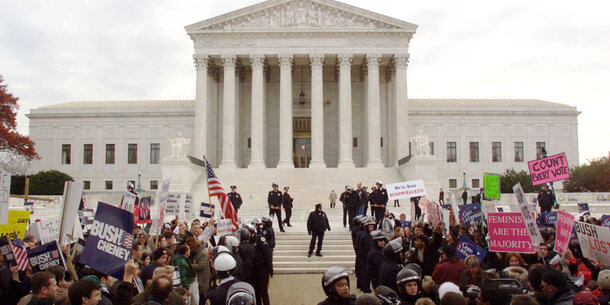The Electoral Count Act governs the process for how the Electoral College selects the president and vice president and Congress tallies electoral votes. The January 6 hearings, including the explosive testimony of former White House aide Cassidy Hutchinson, have shown how the law’s often confusing procedures were exploited by President Trump and others to try to disrupt the peaceful transfer of power, culminating in the violent attack on the Capitol on January 6, 2021.
Congress must take advantage of bipartisan momentum to address the Electoral Count Act’s vulnerabilities as soon as possible. Changes must address the full range of problems with the law, including vague provisions that could make it easier to tamper with future presidential election results in the states. On July 20, 2022, a bipartisan group of senators released legislation that addresses many of these issues. On September 21, 2022, the House passed a similar House bill that covers many of the problems.
At the same time, fixing the Electoral Count Act is not remotely sufficient to protect our democracy. Not only does the law apply only to presidential contests, it simply has no bearing on many of the most significant ongoing threats arising from the falsehoods that fueled the assault on the Capitol — including rampant attacks on election workers, ongoing efforts to manipulate vote counting processes, and the record number of new voter suppression laws.
Fixing the Electoral Count Act is a necessary and important step, but it is no substitute for broader national safeguards.
What are the Electoral Count Act’s key provisions?
The Electoral Count Act governs the process for appointing electors for president, certifying and transmitting electoral votes to Congress, opening and counting the votes, and the resolution of disputes.
Under Article II of the Constitution, states determine how electors for president are appointed — currently, all 50 states and the District of Columbia select electors by popular vote. The 12th Amendment requires electors to meet after the election in their respective states to cast their votes, which are then transmitted to Congress to be opened by the vice president in a joint session.
To win, a candidate must receive “a majority of the whole number of Electors appointed.” If no ticket receives a majority, the House selects the president with each state delegation receiving one vote, and the Senate selects the vice president.
What does the Electoral Count Act say about the appointment of electors?
The Electoral Count Act specifies that electors shall be appointed in each state on Election Day, which since 1845 has been the first Tuesday following the first Monday in November of a presidential election year. But if a state has “failed to make a choice” on Election Day, the law authorizes its legislature to select an alternate date for choosing electors “in such a manner as the legislature of such State may direct.” States may also fill any vacancies among their electors “by law.”
The Electoral Count Act provides no other explanation for what these provisions mean. However, experts have noted that they should be interpreted narrowly, as they date back to a time when states used different methods to select electors, such as runoff elections.
Electors’ appointments must be ratified through a “certificate of ascertainment” issued by the state’s “executive” — usually its governor or secretary of state, depending on state law — who also is the one to transmit the state’s votes to the archivist of the United States, who in turn transmits them to Congress.
What does the Electoral Count Act say about the electors’ casting of votes?
The Electoral Count Act requires electors to meet in their home states and cast their votes “on the first Monday after the second Wednesday in December” following the election. So long as a state resolves any controversy regarding the outcome of the election six days before the Electoral College meets (known as the “safe harbor” deadline), the law treats the state’s appointment of electors as “conclusive.” A slate finalized within the safe harbor can still be rejected by Congress, but the law’s text has been interpreted to mean it will take precedence over slates that did not comply with the safe harbor.
What does the Electoral Count Act say about the procedure for counting votes in the joint session of Congress and the vice president’s role?
The Electoral Count Act sets forth procedures for electoral votes to be opened and counted in a joint session of Congress on January 6 following the presidential election. In addition to opening ballots as required by the 12th Amendment, the law assigns the vice president to preside over the session, but it provides little detail about the extent of their duties.
The Electoral Count Act permits members of Congress to object to votes on two grounds: if a vote was not “regularly given” or if an elector was not “lawfully certified.” There is no additional explanation of what those grounds entail, although there is ample evidence they were intended to be narrow. Nevertheless, an objection only requires support from one senator and one representative to be considered. Where a state certifies a single slate of electors and both chambers vote to sustain objections to all or part of the slate, the relevant votes are not counted, increasing the chance of no ticket receiving a majority and the presidential election being thrown to the House.
Where a state certifies multiple slates of electors, as has happened at least five times in U.S. history, the slate accepted by both chambers will be counted. If the House and Senate disagree, the Electoral Count Act requires Congress to count the slate that “the executive of the state” has certified. There is no provision dealing with what happens if different executives — such as a governor and an independently elected secretary of state — certify different slates.
How was the Electoral Count Act connected to the January 6 insurrection?
The attack on the Capitol was the culmination of a monthslong effort to overturn the 2020 presidential election result. The campaign began with misinformation-driven efforts to delay and disrupt the tallying of votes and certification of electors in key states, including the filing of dozens of frivolous lawsuits. Trump himself pressured state officials, including the secretary of state of Georgia and state legislative leaders in Arizona and Michigan, to set aside election results in their states, declare Trump the winner and appoint his electors.
After these attempts failed, Republicans in seven states still claimed that they were the proper electors in their states and signed false certificates purporting to cast their states’ electoral votes for Trump. Former law professor John Eastman proposed that Vice President Mike Pence, in his role as presiding officer during the joint session on January 6, could unilaterally count these false slates or refuse to count the duly certified slates for Joe Biden to deprive him of a majority and throw the presidential election to the House.
The January 6 committee hearings have revealed that Eastman knew at the time that his proposals were illegal. Nonetheless, Trump championed them, publicly encouraging Pence to reject the actual election results. Pence’s refusal enraged the insurrectionists who stormed the Capitol, some of whom set up a makeshift noose and chanted “hang Mike Pence.”
Even after the storming of the Capitol, when the joint session resumed, minorities in both chambers of Congress still supported baseless objections to electoral slates from key swing states. (Several of those members were recently revealed to have preemptively sought presidential pardons from Trump.) Today, there are still misinformation-driven movements to “decertify” the results in these states, part of a much wider election sabotage campaign in the states.
How could the Electoral Count Act be used to undermine future elections?
As Trump’s failed pressure campaign targeting state officials underscores, the most potent threat to the orderly transfer of power is not disruption of the joint session itself, but malfeasance in the states beforehand.
Experts agree that the Electoral Count Act does not authorize state officials to arbitrarily set aside election results and that doing so would be illegal. But unscrupulous actors may still try to exploit the law’s vague provisions — especially those allowing a state legislature to appoint electors if the state “fails to make a choice” on Election Day and fill elector vacancies “by law” — to justify tampering with presidential election results. Many state legislators have in fact expressed sympathy or outright support for claims the 2020 election was stolen, as have a number of leading candidates for governor and secretary of state in key swing states — making the central role the law assigns to a state’s “executive” another potential source of mischief.
How can Congress fix the Electoral Count Act?
The bill introduced by a bipartisan group of senators and legislation passed by the House, as well as proposals put forward by a number of bipartisan and nonpartisan groups, share many common elements. Effective Electoral Count Act reform must have several components.
First, the law must explicitly confirm that the vice president does not have the power to alter the electoral vote count.
The rules for objections must also be overhauled. Ideally, revisions would reaffirm that the grounds on which Senate and House members may object are narrow. They should also set a reasonable minimum threshold of support for any objection to be considered. If Congress does sustain an objection and disqualifies a slate of electors without accepting another slate, the total number of votes needed for a majority under the 12th Amendment must be correspondingly reduced.
Further, Congress must clarify the rules around the appointment of electors. It should replace the vague language about “failed” elections with clearer language establishing that electors may only be selected after Election Day in very exceptional circumstances that make voting impossible, like a major natural disaster, and that the default remedy in such instances is to extend voting in affected areas, not to redo the election or appoint electors by some other means.
Congress must also take other steps to counter after-the-fact tampering with presidential election results. It should specify that elector vacancies must be filled according to the law as it existed prior to Election Day. Similarly, the identity of the state “executive” who has the power to certify the appointment of electors should also be determined by state law as it existed prior to Election Day.
It also is critical that Congress, while not inviting frivolous litigation, make clear provision for legal actions to require certification of valid presidential election results and to set aside unlawfully certified slates of electors (for example, a slate that is certified before all votes are counted).
Is fixing the Electoral Count Act enough to safeguard our democracy?
No. Electoral Count Act reform is a necessary but incremental solution, one that will primarily clarify existing legal requirements to one aspect of the presidential election process. Broader changes are needed to truly protect against ongoing antidemocratic efforts to subvert our elections. These protections include baseline national standards to secure the right to vote and protect against election sabotage, restoring the Voting Rights Act’s curbs against voting discrimination, better safeguards for election workers, and much more.
It is possible that some relatively minor additional changes may be passed alongside changes to the Electoral Count Act itself. But no incremental package is a substitute for comprehensive reform. The Freedom to Vote: John R. Lewis Act, which passed the House but was narrowly defeated because of the filibuster earlier this year in the Senate, would have addressed many of the major problems our democracy faces. Passage of that bill or one like it must remain the long-term goal.





